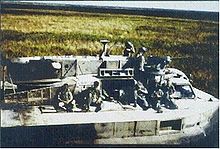Patrol Air Cushion Vehicle
| Patrol Air Cushion Vehicle | |
|---|---|
 Patrol Air Cushion Vehicle |
|
| Overview | |
| Type | Hovercraft |
| units | 7 built, 0 in service |
| 1. Period of service |
|
| period of service |
1966-1970 |
| Technical specifications | |
| displacement |
7.06 tons |
| length |
11.58 meters |
| width |
7.01 meters |
| Draft |
none |
| crew |
2 |
| drive |
Propeller powered by General Electric LM-100 gas turbine with 1014 hp |
| speed |
60 knots |
The Patrol Air Cushion Vehicle , or PACV for short , was a hovercraft that was used by the United States Navy and the United States Army for patrol purposes during the Vietnam War .
technology
The fuselage of the hovercraft was made of aluminum plates that were riveted like in aircraft construction. The apron that sealed the air cushion was made of heavy, reinforced rubber.
The PACVs used a General Electric LM-100 gas turbine with 1,014 hp as a drive . A gearbox transmitted the power and divided it halfway between the four-bladed propeller with a diameter of 2.74 m and the fan for the air apron. Behind the screw there was a large double rudder, which ensured control at high speeds.
The controls were located in the cockpit on the right-hand side and were very similar to the controls of a helicopter . The radar operator's seat was on the left . The DECCA 202 navigation radar was on a mast above the cockpit. The cargo space, which was directly connected to the cockpit, had a capacity of 9 m 3 . The emergency services mostly sat here and on the top covers of the apron. At the bow, between the operator positions, there was a single large hatch that could be opened upwards, which was supplemented by two further hatches on the long sides.
The first models of the Navy had only a single twin 12.7 mm machine gun in a pulpit that could be rotated through 270 ° above the cockpit and M60 machine guns that could be mounted in the windows . The Army models introduced a year later, on the other hand, had two individual 12.7 mm machine guns in separate cockpits, plus additional, remotely controllable 40 mm grenade launchers and M60 on the bow. In addition, the new PACVs had flattened apron covers on which the mounted troops found more space.
history
The first PACVs were delivered in 1966 by the British Hovercraft Corporation as BHC SR-N5 to Bell Aerosystems , where they were equipped with gas turbines and adapted to the requirements of the US Navy. As Bell Sk-5, three vehicles were handed over to the Navy for testing. In the summer of the same year, the unit was relocated to Vietnam and operated under the command of the Mobile Riverine Force mainly in the Mekong Delta . Since hovercraft can travel on water as well as on land, the PACVs were even more versatile than the PBRs previously used . Most of them operated in the wide flood plains and the so-called "Plain of Reeds", a large floodplain on the border with Laos that was densely covered with reeds and which was almost impassable for normal patrol boats.
The Hovercrafts made up for their disadvantage - the high level of noise - with their high speed of 60 knots and great maneuverability. Most of the vehicles, called PacVees by their crews, were mostly driven by helicopter pilots.
In the winter of 1966/67 the hovercraft returned to the USA for overhaul. In the summer of 1967 they were relocated back to Vietnam together with three other, further developed PACVs of the Army. Usually they operated in groups of two in order to be able to give each other fire protection. Many missions were also carried out together with the Green Berets and the Navy SEALs , who appreciated the high speed and thus the element of surprise of the PACVS.
The operations in the mostly inaccessible river and coastal regions lasted until the summer of 1970, when two PACVs were destroyed and the rest were relocated back to the USA.
Web links
- US Army Transportation Museum (Engl.)
Video
- Hovercraft called Patrol Air Cushion Vehicles (PACV) are used in the Vietnam War, in conjunction with Bell UH-1 Iroquois Huey helicopters Narrated by Hollywood actor Dana Andrews . - on military.com

